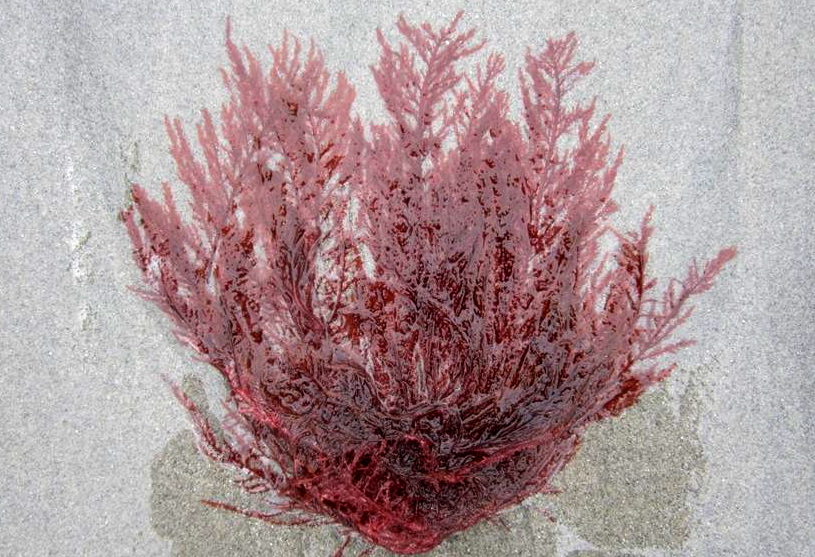Sea fern, red fan • Neoptilota asplenioides
Identification
This red alga has a fern-like branching structure and ranges from dark red to bright pinkish-red. It has many orders of branching composed of opposite branch pairs. The pairs in the last order of branching are uneven, with one branch lengthening and maturing into a reproductive structure over time, while the other branch remains short. The margins of the end branches are toothed. Sea fern has a disc-shaped holdfast and gets to 40 cm tall.
Habitat & Range
Sea fern grows on both rock and other seaweeds from the low intertidal to the shallow subtidal. It most commonly grows in exposed and semi-exposed locations. Its range stretches from northern Washington north to the Bering Sea and Aleutian Islands; it is also found along coastlines of Siberia and Japan.
Similar Species
Neoptilota hypnoides is a similar fern-like red alga. Its end branches lack the serrated edges of N. asplenioides. Other similar species are Ptilota sp., P. serrata, N. densa, and N. californica.
This red alga has a fern-like branching structure and ranges from dark red to bright pinkish-red. It has many orders of branching composed of opposite branch pairs. The pairs in the last order of branching are uneven, with one branch lengthening and maturing into a reproductive structure over time, while the other branch remains short. The margins of the end branches are toothed. Sea fern has a disc-shaped holdfast and gets to 40 cm tall.
Habitat & Range
Sea fern grows on both rock and other seaweeds from the low intertidal to the shallow subtidal. It most commonly grows in exposed and semi-exposed locations. Its range stretches from northern Washington north to the Bering Sea and Aleutian Islands; it is also found along coastlines of Siberia and Japan.
Similar Species
Neoptilota hypnoides is a similar fern-like red alga. Its end branches lack the serrated edges of N. asplenioides. Other similar species are Ptilota sp., P. serrata, N. densa, and N. californica.
References
Lamb, A., and Hanby, B. (2005). Marine Life of the Pacific Northwest [electronic version]. Madeira Park, BC: Harbour Publishing.
Lindberg, M. and Lindstrom, S. (2010). Neoptilota asplenioides. Seaweeds of Alaska. Accessed 23/01/2015.
O'Clair, R. and Lindstrom, S. Neoptilota asplenioides (Esper) Kylin. In Klinkenberg, Brian. (Ed.). E-Flora BC: Electronic Atlas of the Plants of British Columbia. Lab for Advanced Spatial Analysis, Department of Geography, University of British Columbia, Vancouver. Accessed 23/01/2015.
Authors and editors of page
Kelly Fretwell and Brian Starzomski (2015).
Lamb, A., and Hanby, B. (2005). Marine Life of the Pacific Northwest [electronic version]. Madeira Park, BC: Harbour Publishing.
Lindberg, M. and Lindstrom, S. (2010). Neoptilota asplenioides. Seaweeds of Alaska. Accessed 23/01/2015.
O'Clair, R. and Lindstrom, S. Neoptilota asplenioides (Esper) Kylin. In Klinkenberg, Brian. (Ed.). E-Flora BC: Electronic Atlas of the Plants of British Columbia. Lab for Advanced Spatial Analysis, Department of Geography, University of British Columbia, Vancouver. Accessed 23/01/2015.
Authors and editors of page
Kelly Fretwell and Brian Starzomski (2015).




